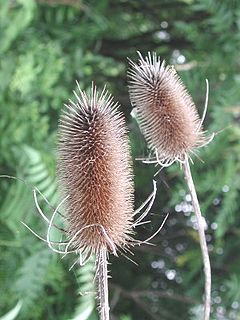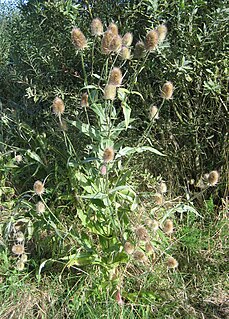
The Dipsacaceae have been recognized as a family of the order Dipsacales containing 350 species of perennial or biennial herbs and shrubs in eleven genera. The species are currently placed in the family Caprifoliaceae. Native to most temperate climates, they are found in Europe, Asia, and Africa. Some species of this family have been naturalized in other places. The spikes of the common teasel (pictured) are not particularly spiny and may be quite soft. In some places, the spikes are used in cotton threading.

Biological control or biocontrol is a method of controlling pests such as insects, mites, weeds and plant diseases using other organisms. It relies on predation, parasitism, herbivory, or other natural mechanisms, but typically also involves an active human management role. It can be an important component of integrated pest management (IPM) programs.

The Worshipful Company of Clothworkers was incorporated by Royal Charter in 1528, formed by the amalgamation of its two predecessor companies, the Fullers and the Shearmen. It succeeded to the position of the Shearmen's Company and thus ranks twelfth in the order of precedence of Livery Companies of the City of London.

Integrated pest management (IPM), also known as integrated pest control (IPC) is a broad-based approach that integrates practices for economic control of pests. IPM aims to suppress pest populations below the economic injury level (EIL). The UN's Food and Agriculture Organization defines IPM as "the careful consideration of all available pest control techniques and subsequent integration of appropriate measures that discourage the development of pest populations and keep pesticides and other interventions to levels that are economically justified and reduce or minimize risks to human health and the environment. IPM emphasizes the growth of a healthy crop with the least possible disruption to agro-ecosystems and encourages natural pest control mechanisms." Entomologists and ecologists have urged the adoption of IPM pest control since the 1970s. IPM allows for safer pest control.

Dipsacus is a genus of flowering plant in the family Caprifoliaceae. The members of this genus are known as teasel, teazel or teazle. The genus includes about 15 species of tall herbaceous biennial plants growing to 1–2.5 metres (3.3–8.2 ft) tall. Dipsacus species are native to Europe, Asia and northern Africa.

A biological agent is a bacterium, virus, protozoan, parasite, or fungus that can be used purposefully as a weapon in bioterrorism or biological warfare (BW). In addition to these living or replicating pathogens, toxins and biotoxins are also included among the bio-agents. More than 1,200 different kinds of potentially weaponizable bio-agents have been described and studied to date.

Dipsacus fullonum, syn. Dipsacus sylvestris, is a species of flowering plant known by the common names wild teasel or fuller's teasel, although the latter name is usually applied to the cultivated species Dipsacus sativus. It is native to Eurasia and North Africa, but it is known in the Americas, southern Africa, Australia and New Zealand as an introduced species and often a noxious weed. It forms large monocultures in areas it invades that have favorable climates and none of its biological control species. The inflorescence is a cylindrical array of lavender flowers which dries to a cone of spine-tipped hard bracts. It may be 10 centimeters long.

Dipsacus pilosus, or small teasel, is a species of biennial flowering plant in the family Caprifoliaceae. The epithet small refers to the flower heads which are smaller, globular and made up of white flowers with violet anthers and woolly spines.

Stanford End Mill and River Loddon is a 11.8-hectare (29-acre) biological Site of Special Scientific Interest south of Reading in Berkshire. It covers Stanford End Mill meadows and a 4 kilometres stretch of the River Loddon between Stanford End and Sheep Bridge north-west of Swallowfield.
D. sylvestris may refer to:
Murexsul dipsacus is a species of sea snail, a marine gastropod mollusk in the family Muricidae, the murex snails or rock snails.

Endothenia gentianaeana is a moth of the family Tortricidae. It is found from most of Europe, east to Korea and the Near East. It is also found in North America and Hawaii.

Nemophora raddaella is a moth of the Adelidae family that is found in southern Europe.

Dipsacus laciniatus is a species of flowering plant in the honeysuckle family known by the common name cutleaf teasel. It is native to Europe and Asia. It is present in North America as an introduced species and invasive weed.
In Greek mythology, Phyllis (Φύλλις) was the god of the homonymous river in Bithynia. By a local meadow nymph, he became father of a son Dipsacus, who led a pastoral lifestyle by his father's river and was remembered for having been hospitable to Phrixus on the latter's way to Colchis.
Teazle, teasle, teazel or teasel may refer to:

Endothenia marginana, the downland marble, is a moth of the family Tortricidae. It was described by Adrian Hardy Haworth in 1811. It is found in almost all of Europe.

Diceratura ostrinana is a species of moth of the family Tortricidae. It is found from Algeria and the Iberian Peninsula to Hungary, Albania and the Crimea. It is also found in Asia Minor, Lebanon, Transcaucasia, Siberia and Iran.

Abia sericea, common name Club Horned Sawfly or Scabious Sawfly, is a species of sawflies belonging to the family Cimbicidae.













